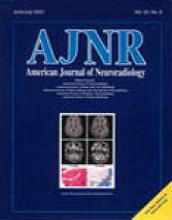Ischemic stroke may occur as a complication of any vascular intervention from the heart to the head. These interventions include diagnostic arteriography, coronary revascularization, valve repair, carotid endarterectomy or angioplasty, and endovascular obliteration of aneurysms by use of detachable coils. Nearly all strokes associated with these procedures are attributable to embolic material lodging in distal cerebral arteries.
Efforts to reduce the stroke risk from cerebrovascular interventions are limited by several complicated factors. First, the nature of the embolic material generated during these procedures varies widely and, consequently, the potential for causing ischemic injury to the brain is variable. Embolic material can range from air bubbles, microscopic cholesterol or lipid particles, to larger fragments of atherosclerotic plaque and organized thrombus (1–3). Second, the embolic insult can vary in the total number of particles in the temporal profile of the particle shower. A slow trickle of microscopic particles may have less potential for ischemic injury than the same number of particles delivered in a sudden shower. Third, the potential for an embolic event to result in injury depends on the condition of the cerebral tissue. Given an identical embolic insult, cerebral tissue with reduced perfusion pressure (due to proximal stenosis or occlusion, for example) has a greater risk of permanent ischemic injury than does brain with normal perfusion pressure. Finally, the low frequency of stroke in these procedures makes it difficult to perform studies with adequate power to detect changes in stroke risk with different devices of pharmacological adjuncts.
A surrogate marker for clinical stroke that occurs at a greater frequency would have considerable utility in studies of stroke risk reduction during neurointerventional procedures. At present, there are two complementary methods that have potential for this application: transcranial Doppler (TCD) (4) and, as discussed by Jaeger et al in this issue of the AJNR (page 1251), diffusion-weighted imaging (DWI).
The primary advantage of TCD is its capability for real-time monitoring of embolic events during the procedure. Embolic signals, with no clinical sequelae, have been detected by TCD in the middle cerebral artery stem among patients with symptomatic carotid stenosis, artificial heart valves, and polycythemia rubra vera. Asymptomatic signals have also been recorded during diagnostic arteriography, carotid endarterectomy or angioplasty, and endovascular treatment of aneurysms. The sensitivity of TCD to small, clinically benign, embolic particles and the potential for real-time monitoring has been exploited in studies of right-to-left cardiac shunts, such as patent foramen ovale. Microbubbles injected in an arm vein can be identified with similar sensitivity in the middle cerebral artery among patients with patent foramen by use of TCD as with cardiac echocardiography. The real-time monitoring capability of TCD could be used to determine which steps during a procedure are associated with the greatest number of embolic events. Some evidence suggests that a large number of cerebral emboli during coronary bypass surgery occur with cross-clamping of the aorta. In carotid angioplasty and stenting, this could be during predilation or stent deployment or post stent angioplasty. Information regarding the relative embologenic potential of each step could guide the development or use of devices to prevent this occurrence. The primary drawback to TCD, with current technology, is its inability to distinguish either the nature or size of the embolic material as well as the effect of the emboli on the brain itself. Dual-frequency TCD techniques to distinguish air bubbles from solid material are under development.
DWI, as reported in this issue and prior studies, offers important complementary information: a quantitative assessment of ischemic injury (5, 6). DWI lesions can be quantified by size and number. The frequency of these lesions is in great excess to frequency of ischemic stroke. In these regards, DWI may serve as a useful surrogate endpoint for clinical stroke. Jaeger and colleagues report new DWI lesions in eight of 25 vascular territories after angioplasty of atherosclerotic lesions of the carotid, vertebral, or innominate arteries. They performed DWI before and 24 hours after the procedure. No clinical neurologic deficits were observed. Similar results were reported by Rordorf et al (5) after endovascular treatment of 14 intracranial aneurysms by means of Guglielmi detachable coils. DWI lesions were found at 48 hours in eight patients. One of the eight patients had clinical evidence of a stroke. Bendszus et al (6) reported new DWI lesions in 17 of 66 patients undergoing diagnostic cerebral arteriography.
One could argue that clinically silent lesions may not matter or that clinical stroke is a different entity than these small, silent lesions. However, it is much more likely that clinically evident stroke represents the tip of the iceberg of embolic ischemic events. The literature concerning significant neuropsychological changes in the absence of clinical stroke occurring with cardiopulmonary bypass procedures and strongly associated with probable microembolic events support this hypothesis (2, 7).
In summary, DWI may serve as a useful surrogate endpoint for ischemic stroke in the investigation of new devices, drugs, and techniques for cerebrovascular intervention. The frequency of new lesions by discovered by DWI appears to be quite high for angioplasty and aneurysm treatment. The DWI lesions are measurable in both size and number. These factors will provide good statistical power for the detection of differences in event rates between control and experimental groups. The evidence linking DWI lesions with ischemic injury is strong. TCD also plays a useful and complementary role in these investigations with its capability for real-time monitoring of embolic events.
- Copyright © American Society of Neuroradiology












